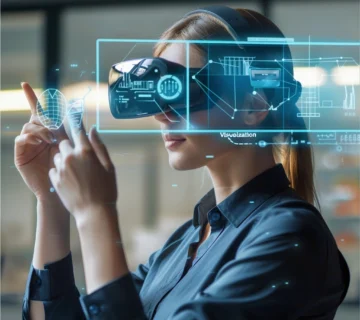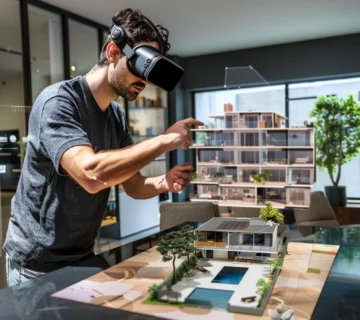Immersive Architecture: A New Connection Between Two Worlds of Reality and Virtual
Introduction
In a world where technology continually blurs the boundaries between the real and the virtual, architecture is undergoing a revolutionary transformation. Immersive architecture is at the forefront of this change, acting as a bridge between two distinct worlds: the physical environment we inhabit and the virtual landscapes we explore. In this article, we will explore how immersive architecture is reshaping our understanding of reality and virtual environments, creating new connections that have the power to change the way we live and experience spaces.
The Fusion of Real and Virtual
Immersive architecture is redefining the concept of architecture design by embracing a fusion of real futuristic architecture and virtual elements. This innovative approach revolves around creating environments that go beyond the static confines of traditional spaces. Instead, it weaves the physical and virtual realms together, immersing individuals in experiences that are both tangible and intangible.
Key Elements of Immersive Architecture
1.Virtual Reality (VR) and Augmented Reality (AR):
“Augmented reality (AR) software has been a common feature in professional design toolkits for a while. But the recent release of Apple’s Vision Pro glasses shows the mixed-reality wearables sector is making serious inroads in consumer markets too, as one of the world’s biggest names in consumer design and technology enters the market.”[archdaily]
Immersive architecture harnesses the power of VR and AR technologies to introduce virtual interactive architecture components into physical spaces. With VR, users can enter entirely new worlds, while AR overlays digital information onto the real world. Architects leverage these technologies to create interactive, engaging environments that are at once real and surreal.
2.Sensory Engagement :
Immersive architecture is designed to engage the human senses on a profound level. It incorporates elements like soundscapes, scents, and tactile experiences, ensuring that users are fully immersed in the environment. This sensory engagement deepens the connection between the physical and virtual.
3.Adaptive Environments:
Immersive architectural spaces adapt to the needs and desires of their users. They respond to human presence, allowing individuals to influence and shape their surroundings. Adaptive environments promote personalization and empowerment, fostering a more intimate connection with space.
4.Redefining Spaces and Experiences:
Immersive architecture is reshaping the way we perceive and interact with physical spaces. It transforms a simple room into a canvas for endless possibilities. For example, a regular museum exhibit can become an interactive journey through time, allowing visitors to witness historical events firsthand. A park can transport people to a fantastical world, thanks to AR-enhanced surroundings. A retail store can offer a unique, personalized shopping experience through VR-based showrooms.
5.Enhancing Learning and Entertainment
The impact of immersive architecture extends to education and entertainment. Educational institutions can use immersive spaces to offer students immersive history lessons or science experiments, making learning more engaging and memorable. Entertainment venues can transport audiences to magical realms where they can be part of the story, not just spectators.
Immersive Architecture:
Immersive architecture takes the concept of architectural design to a whole new level by creating environments that fully immerse the user in a sensory experience. These spaces are designed to captivate and engage all the senses, including sight, sound, touch, and even smell. Virtual reality (VR), augmented reality (AR), and mixed reality (MR) technologies play a significant role in immersive architecture, allowing architects to figure the exterior architecture design that transport occupants to other worlds or provide unique and captivating experiences. For example, immersive architectural designs can recreate historical environments, simulate fantastical landscapes, or transport users to futuristic settings, all within the confines of a physical structure. Immersive architecture is not only about aesthetics but also about storytelling and creating emotional connections between the architecture and its occupants.
Both interactive and immersive architecture concepts are instrumental in shaping the future of architecture design. They enable modern architecture to push the boundaries of creativity, offering endless possibilities for creating spaces that are not only visually striking but also highly functional and engaging. These concepts emphasize the idea that the architecture of the future will be a dynamic and interactive part of our lives, constantly evolving and adapting to our needs and desires. As technology continues to advance, we can expect to see even more innovative applications of these concepts, further blurring the line between the physical and digital worlds and redefining the way we experience and interact with architectural spaces.
Explore the potential applications and future directions for immersive architecture:
The potential applications and future directions for immersive architecture are vast and exciting. Immersive architectural design has already found its place in various domains, including entertainment, education, healthcare, and retail. Looking ahead, we can anticipate its further integration into urban planning, public spaces, and even personal homes. As technology advances, immersive architecture is likely to become more accessible and affordable, allowing a broader range of projects to incorporate its principles. This could lead to the creation of smart cities with immersive urban experiences, sustainable buildings with adaptive interiors, and personalized virtual environments tailored to individual preferences. The future of immersive architecture holds the promise of a world where our physical and virtual realms seamlessly intertwine, opening the door to limitless creative and functional possibilities.
here are some examples of immersive architectural projects that have garnered attention for their innovative use of technology:
1.The Rain Vortex at Jewel Changi Airport, Singapore:
One of the world’s largest indoor waterfalls, the Rain Vortex at Jewel Changi Airport in Singapore is an excellent example of immersive architecture. This captivating indoor waterfall is surrounded by lush greenery and integrated with light and sound elements, creating a multisensory experience that has wowed travelers from around the globe.
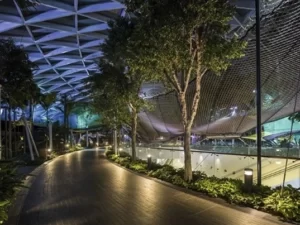
2.The National Museum of Qatar, Doha:
The National Museum of Qatar is a striking architectural marvel that employs immersive technology to tell the story of Qatar’s rich history and culture. Visitors can explore interactive exhibits, projection mapping, and AR experiences that transport them through time and space, making it a prime example of how immersive architecture enhances museum experiences.
3.The Euronews Headquarters, Lyon, France:
The Euronews Headquarters in Lyon features a unique kinetic façade made up of thousands of tiny tiles. These tiles can move, creating dynamic and ever-changing patterns on the building’s exterior. The façade’s real-time responsiveness to environmental factors, such as wind and light, exemplifies how interactive architecture can redefine the aesthetics of a structure.
Figure 2:The Euronews Headquarters, Lyon, France
4.The Royal Ontario Museum’s ‘Future Memory’ Exhibit, Toronto:
The ‘Future Memory’ exhibit at the Royal Ontario Museum employs immersive design and AR technology to engage visitors in thought-provoking experiences. It allows users to explore and understand various scenarios related to climate change and its effects on the environment, creating an interactive and educational architectural exhibit.
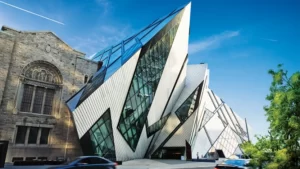
5.The Museum of the Future, Dubai:
The Museum of the Future in Dubai is a striking example of how immersive architecture can shape the landscape. Its unique, futuristic design is not just aesthetically stunning but also integrated with advanced technologies to create immersive and interactive experiences that explore the possibilities of emerging technologies.
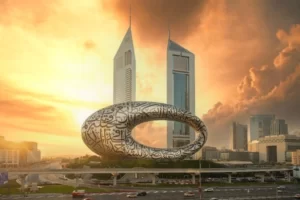
Conclusion
Immersive architecture is revolutionizing the way we perceive, experience, and interact with our environments. By seamlessly blending the physical and virtual worlds, it creates new connections and opportunities for innovation across various fields. This transformative approach to architecture has the potential to enrich our lives, spark creativity, and push the boundaries of what is possible. As technology continues to evolve, immersive architecture will continue to bridge the gap between the two realities, opening new horizons in the way we design, build, and inhabit spaces. The future of architecture is indeed immersive, and it promises a dynamic and vibrant relationship between the real and the virtual



